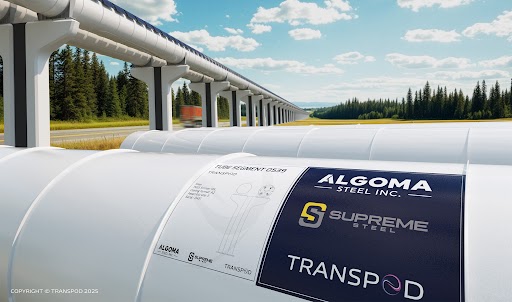Steel Mills

HARDI: Distributors Hope Strong Demand Will Counter Weak Prices
Written by Tim Triplett
January 18, 2022
Distributors who sell galvanized steel products to the construction and HVAC sectors are counting on demand remaining healthy this year to get them through a difficult period of inventory adjustments amid sharply declining steel prices.
![]()
“One positive, demand is still pretty strong. We’re coming off heights we’ve never seen before,” said one member of the Heating, Air-Conditioning & Refrigeration Distributors International, during HARDI’s monthly conference call today. “When the market plunged in 2008-09, demand just shut off. In this market, prices are decreasing, but we can still sell steel.”
Steel Market Update data put the average galvanized steel price at $1,880 per ton ($94/cwt) as of Jan. 11, down from a peak of $2,185 per ton in September. “There had been expectations that prices would fall at a moderate pace. But there is nothing moderate about a 14% decline from that 2020 peak,” said SMU Senior Editor Michael Cowden speaking on the call.
Those who have been monitoring lead times – a leading indicator of steel prices – should not be surprised, he added. Lead times for mill orders of galvanized products have declined sharply from more than 13 weeks last summer to about seven weeks more recently—nearly back to historical averages.
Prices for hot rolled coil have been falling even faster than for galvanized, ballooning the spread between the two to as much as $400, more than double the historical norm. “And I just don’t think that is sustainable,” Cowden said.
Another factor putting downward pressure on galvanized prices is the high inventory levels among service centers. At an average of 64 shipping days of supply, stock levels are the highest they have been since May 2020, following the outbreak of COVID-19 in North America. “It’s not great to have high inventories – much of which were purchased when steel was at its highest price ever – with prices almost certainly set to fall even further,” Cowden told the distributors.
In a flash poll of the HARDI members on the call, virtually all said they expect galvanized prices to decline by at least another $40 per ton ($2/cwt) in the next 30 days. About 48% predict an $80 drop ($4/cwt), while another 28% foresee prices plunging by $120 ($6/cwt) or more in the coming month.
Asked to predict where galvanized prices will be six months from now, 90% said they anticipate further declines totaling $120-200 per ton ($6-10/cwt). Their guesses for the galvanized base price as of Sept. 30, 2022, range anywhere from a high of $1,600-1,780 per ton ($80-89/cwt) to a low of $1,000-1,180 ($50-59/cwt). A weighted average of their responses would put the galvanized price around $1,400 per ton ($70/cwt), a further decline of $480 per ton, or 25%, by the end of the third quarter.
Based on the following comments from the HARDI members on the call, managing their inventories is their top priority as prices continue to correct from the record highs last year:
“The price we are at now is still not the new norm. We are trying to manage our inventory accordingly, only buying as needed. Sales were pretty good in December. January is seasonally slow. Everyone is taking it day by day and trying not to be overstocked.”
“The price decreases seem to have accelerated since the beginning of the year. We have tighter inventories on the floor due to strategic partnerships and shorter mill lead times. Do you move material at a loss to be able to replace it at a lower number? As they say, ‘Take the loss now. The first loss is usually the best loss.’”
“We had a fortunate 2021. We are in a healthy inventory position. You have to buy steel, you have to have it if you are going to sell it. All the feedback from our contractors remains pretty optimistic, with a lot of projects on the books. It is good to see demand strong.”
“I think the demand side is what may keep this thing propped up. When you have people who sit on their hands, it’s not good for demand. We may end up with a restocking cycle in late spring or summer [because of the delayed purchases].”
“Demand is still good. Everyone is in an inventory-moving mode. Street prices seem to be falling quicker than the market. The question is, what will happen with the mills? Will they flex their muscles and try to control the market?”
Cowden finished on an optimistic note, pointing out that today’s market is unusually volatile for unprecedented reasons. “Underlying demand seems to be good. So, I’d keep an open mind about other factors that haven’t traditionally come into play – inflation, COVID, shortages, etc. Yes, it’s dumb and easy to say this time is different. … But it’s also dumb and easy to say this time is the same.”
Steel Market Update participates in a monthly steel conference call hosted by HARDI. The call is dedicated to a better understanding of the galvanized steel market. The participants are HARDI member companies, wholesalers who supply products to the construction markets. Also on the call are service centers and manufacturing companies that either buy or sell galvanized sheet and coil products used in the HVAC industry and are suppliers to the HARDI member companies.
By Tim Triplett, Tim@SteelMarketUpdate.com

Tim Triplett
Read more from Tim TriplettLatest in Steel Mills

AISI: Raw steel production drops to multi-month low
After being historically strong for more than four months, US raw steel production fell for a second week.

U.S. Steel sues Algoma over iron pellet shipments
U.S. Steel is suing Algoma over the Canadian flat-rolled producer's rejection of iron pellet shipments, arguing it has breached its contract.

August US mill shipments slip but still higher than last year
The American Iron and Steel Institute reported a decline in the monthly shipments of US mills from July to August.

TransPod, Algoma, Supreme Steel linkup anchors Canadian steel in high-speed transit build
The three Canadian companies have announced a strategic partnership to support the development of an ultra-high-speed transit line from Edmonton to Calgary.

Metallus, USW agree to tentative four-year labor deal
Metallus and the United Steelworkers (USW) have agreed to a tentative four-year labor contract.
